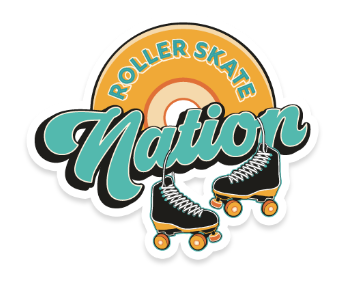FAQs About Roller Skate Wheels, Bearings, and More
Get answers and explanations to all of your roller skate wheel and bearing questions including what dimensions you need and more with our comprehensive guide.
- What do the roller skate wheel hardness and size mean?
Every wheel has 2 numbers that are important to pay attention to. One refers to durometer (hardness) and the other refers to diameter (size).
- Wheel Hardness is measured on the Shore scale
Indicated by the letter "A" after the number, "A" scales measure harnesses of Urethane Compound Wheels. The lower the number, the softer the wheel (more grip). The higher the number the harder the wheel (less grip). - Wheel Diameter is measured in millimeters
The smaller the wheel diameter, the lower your center of gravity and the easier you can maneuver. The larger the wheel diameter, the higher your center of gravity and the more traction you will have.
Extra Small, 47mm-55mm wheels are typically very hard and used for sliding and shuffle skating (highest maneuverability, glide easily)
Small, 57mm wheels are used primarily for freestyle/artistic skating (high maneuverability)
Mid-Size, 62mm wheels are used for indoor skating, speed, derby & dance skating (some traction, sustained speed)
Large, 60mm - 70mm wheels are used for outdoor skating (highest traction)
- How does the size of my wheels affect the speed?
Wheel widths range from 27mm to 42mm and heights range from 47mm to 70mm. Wider, larger wheels (60mm-70mm) are great for outdoor traction and indoor speed. Smaller wheels (57mm) are needed for artistic or rhythm skating because while slower, they offer greater maneuverability.
- What is the difference between indoor and outdoor wheels?
The simplest answer to this question is that indoor wheels are harder, and outdoor wheels are softer. Most skaters use a softer wheel (78A-82A hardness) for outdoor skating and a harder wheel (over 90A hardness) for indoor skating. A softer wheel absorbs more shock as you roll over textured or uneven surfaces such as sidewalks and streets. A softer wheel offers greater rebound, which allows the wheel to roll over uneven surfaces, rather than bouncing over them. A soft wheel typically has a lot of grip, while a harder wheel will have less grip and offer a better (less "sticky") roll on smooth surfaces such as skating rinks, ramps, bowls and smooth concrete.
"Hybrid" or Indoor/Outdoor wheels are typically found at 85A hardness. This hardness is typically found on kids skates and some beginner skates.
- What size bearings do I need for my wheels?
Many incorrectly assume that your wheels determine your bearing size. In reality, the size of the axles on your skates determine which size bearings you need. Axles are commonly available in two sizes, 7mm (9/32) or 8mm (5/16). Most current skates are manufactured with an 8mm axle because 8mm bearings and locknuts are more common and readily available, however some high end plates (Labeda Proline, Sure-Grip Power-Trac, Sure-Grip Snyder and Roll Line) still use an 7mm axle.
If you are unsure which size axles are on your skates, you can tell by checking the bearings you currently have to see if they are 7mm or 8mm.
There are 3 very easy ways to check the roller skate bearing size you have.
- Look at the stamping on the shield of your existing skate bearing. Most will be stamped with 608. This means you have 8mm. If stamped with 627, you have a 7mm bearing.
- You can also tell by the size of the wheel nut. A 9/32" nut will indicate a 7mm bearing. A 5/16" nut will indicate a 8mm bearing.
- Take a number 2 pencil using the eraser side of the pencil. Try sliding the bearing onto the pencil. If it is too big to fit through the center it is a 7mm bearing, but if the same pencil slides right through you have a 8mm bearing.
- What is the proper maintenance for my wheels?
You will need to check your wheels from time to time to make sure they are spinning properly and have not become excessively worn. If the wheels are not spinning freely you should check for damage, or buildup from dirt or other debris. If the roller skate wheels are damaged they should be replaced. RollerSkateNation.com offers a lot of replacement quad and inline wheels for you to choose from. If they are simply dirty, take the time to remove and clean the wheels as necessary.
- How can I slow down my wheels on my new skates?
We do not suggest tightening your axle nuts, as they can easily be overtightened and damage the bearings, causing them to fail. We recommend replacing your bearings with Slow Roll substitute bearings, which will slow down your wheels while you learn to skate. As you become more comfortable, you can replace the Slow Roll bearings with regular bearings.
- Why it's important to rotate your skate wheels and how often should they be rotated?
Rotating your wheels regularly will make them last longer, because they will wear more evenly. Skate wheels usually wear out faster on one edge than the other, and most people wear down some of their wheels faster than others. It is recommended that wheel locknuts not be used more than two times. Worn nylon on the locknuts may cause the locknut to back off, potentially causing your wheel to come off.
When to rotate skate wheels:
You will know it's time to rotate your skate wheels, when you see that one side of your wheels - usually the inside edge - is wearing down more quickly than the other. Another signal is when you can see that some of your wheels are noticeably larger than others, but if you can see this difference, you have probably waited too long.
After you rotate your wheels:
Freshly rotated wheels can feel a bit strange when you skate on them and it can be difficult to keep your balance. This problem can be reduced by rotating your wheels frequently, and by rotating the largest wheels to the front and back positions. If you your wheels do feel strange after rotating, they will feel normal again after a few days of hard skating
- What is the difference between roller skate wheels?
There are basically 5 main different types of roller skate wheels:
- Wide Wheels (Speed Wheels) - Designed to grip the skating floor and allow you to gain traction while gaining speed.
- Artistic/Dance Wheels - Designed to be hard wheels that are not "grippy" to allow for the dance style moves in skating.
- Outdoor Wheels - These are softer wheels that are designed to be able to absorb the uneven terrain of outdoor skating surfaces (e.g. trails, sidewalks, boardwalks, roads).
- Derby Wheels: The wheels are designed for the sport of Roller Derby. These allow the different positions in Derby to be able to stop quickly, go quickly, and go at fast speeds. They are also sized appropriately for maneuverability.
- Ramp/Bowl Wheels: These wheels are typically narrow wheels (55mm-59mm, and narrower (34mm) and are harder than typical outdoor wheels (92A-97A) due to their use on smooth concrete surfaces.
- How do you measure roller skate wheel size and what is the range of inline skate wheel sizes?
The diameter or height of a skate wheel is measured in millimeters (mm). Wheels used for quad skates range from approximately 47mm to 70mm in diameter. Inline skate and rollerblade wheel sizes range from approximately 60mm-125mm.
Small wheels will provide the maneuverability needed for aggressive skating, figure skating, roller dancing, and hockey.
A larger wheel will provide the smooth ride and faster speed that is desirable for fitness and speed skating, however accelerating from a stop to full speed will require more effort on very large wheels.
Before you purchase new wheels for your skates, make sure the wheel size you are buying will fit on your skates and frames.
And remember when buying wheels bearings do not come with your new wheels.
- What are hubs?
Hubs sit on the inside of some wheels and are nylon or aluminum. Nylon hubs are lighter and are somewhat pliable. Aluminum hubs are heavier and not pliable, meaning a longer roll and more energy transfer. Both nylon and aluminum hubs are much lighter than the urethane they replace.
Soft wheels below 84A need a hub to reinforce the bearing seat in the wheel. Under normal conditions, an 84A wheel will hold the bearings, but not under extreme conditions. Hubs are used on harder wheels to lower the weight of the wheel.
- How do I change the wheels on my quad skates?
Click here to watch our instructional video!
- Unscrew the nut from each wheel with your skate tool. Place the tool over the nut, and turn it counterclockwise until the nut comes off.
- Remove the wheels from their bolts.
- Put the new wheels on the bolts.
- If the locknuts have been used more than two times, it is highly recommended that new wheel locknuts be used. Slide the nut onto the bolt, flat end first, and turn it clockwise with your fingers. Finish tightening the nuts with your skate tool.
Test the wheels to make sure the nuts aren't too tight. Spin each wheel with your fingers. The wheel should spin freely. If the wheel doesn't spin or is jerky when it spins, the nuts are to tight and need to be loosened.
- Why do my wheels have holes in them?
Top end wheels for jam skating, inline speed skating or track skating are made from a material called POLY BD. This specific material has exceptional grip while providing excellent rebound yet remains stiff enough to deliver a quality roll. The POLY BD also has a very high viscosity which means it pours very slowly when cast and as it cures, tiny air bubbles are caught inside the wheels. These tiny air bubbles show up as holes in the wheel when the running surface is trimmed, as well as, when the wheels wear down and more holes come to the surface.
Do not worry about the holes, these bubbles do not affect the performance of the wheels and in fact, they prove that the material is truly POLY BD which enhances the performance of the wheels on skating surfaces.
- How do I tighten or loosen the wheels on my quad skates?
Flip the first skate over, wheel side up. Locate the two external tension nuts at both of the wheel axles.
- Attach the correct socket wrench (usually 1/2 inch) to the ratchet body of your wrench.
- Fit the wrench on to the bolt and move the handle right and then left, until the nut reaches the appropriate tightness.
- Feel the nut with your fingers to test the tightness. If you can turn the locknut with your fingers, they need to be replaced with new locknuts. Loosen or tighten as needed. A medium tightness is recommended.
- Repeat on the final seven nuts.



